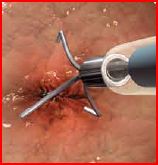- Haemoclips are mechanical devices used to approximate two sides of a vessel to immediately, definitively, and securely occlude and arrest bleeding. On opening, the haemoclip is typically 11–12 mm wide from jaw to jaw.
- Haemoclips are best deployed enface rather than tangentially. Haemoclip need to be placed at the correct angle and precise spot. Missing a target, even slightly, can render a haemoclip ineffective.
- At least two haemoclips are generally placed to clamp an actively bleeding artery in an ulcer. Haemoclips are relatively inefficacious for arteries that are larger than 2 mm wide. Haemoclips generally fall off 10–14 days after deployment—after the lesion has partly healed and when the lesion is unlikely to rebleed.
- The placement of these clips rarely produces complications other than failed efficacy. Haemoclips are less successful for the treatment of fibrotic lesions such as chronic ulcers.
- Hemoclips and thermocoagulation or electrocoagulations are equally efficacious in achieving long term haemostasis.
Triclip
Three proprietary haemoclips are commercially available:
- QuickClip2™ (Olympus, Lake Success, NY)- it is rotatable and comes in two sizes (8 mm or 12 mm open clip width);
- TriClip (Wilson-Cook, Winston-Salem, NC)- this is a three-pronged clip that opens to 12 mm in width;
- Resolution Clip (Boston Scientific, Natick, MA), which is non rotatable but reversible and has an 11 mm open clip width.
A rotatable haemoclip can be rotated by turning the handle of the clipping device. A reversible haemoclip is still attached to the deployment device after the clip has been closed, and the closing of the haemoclip can be undone by reversing this step.







